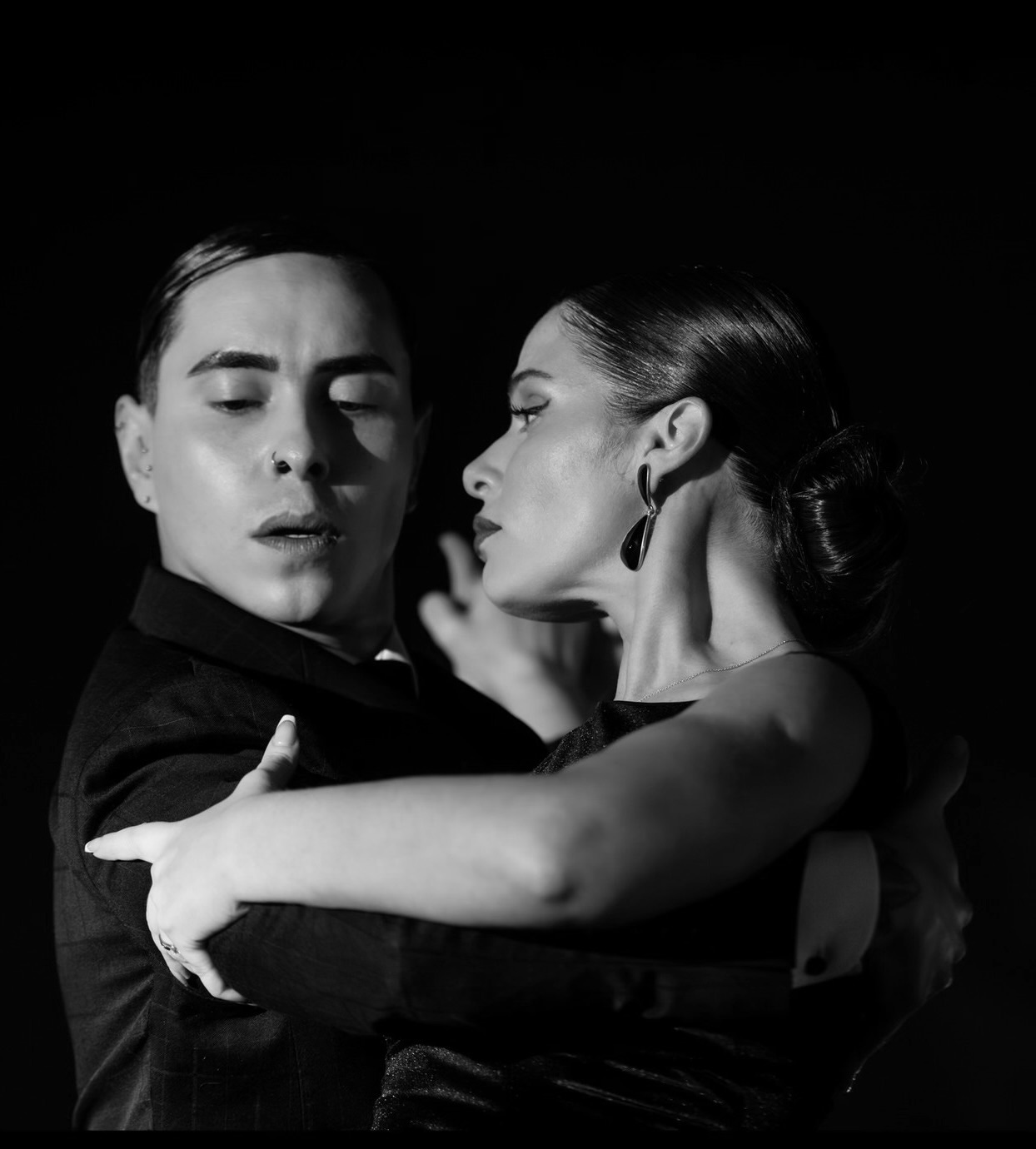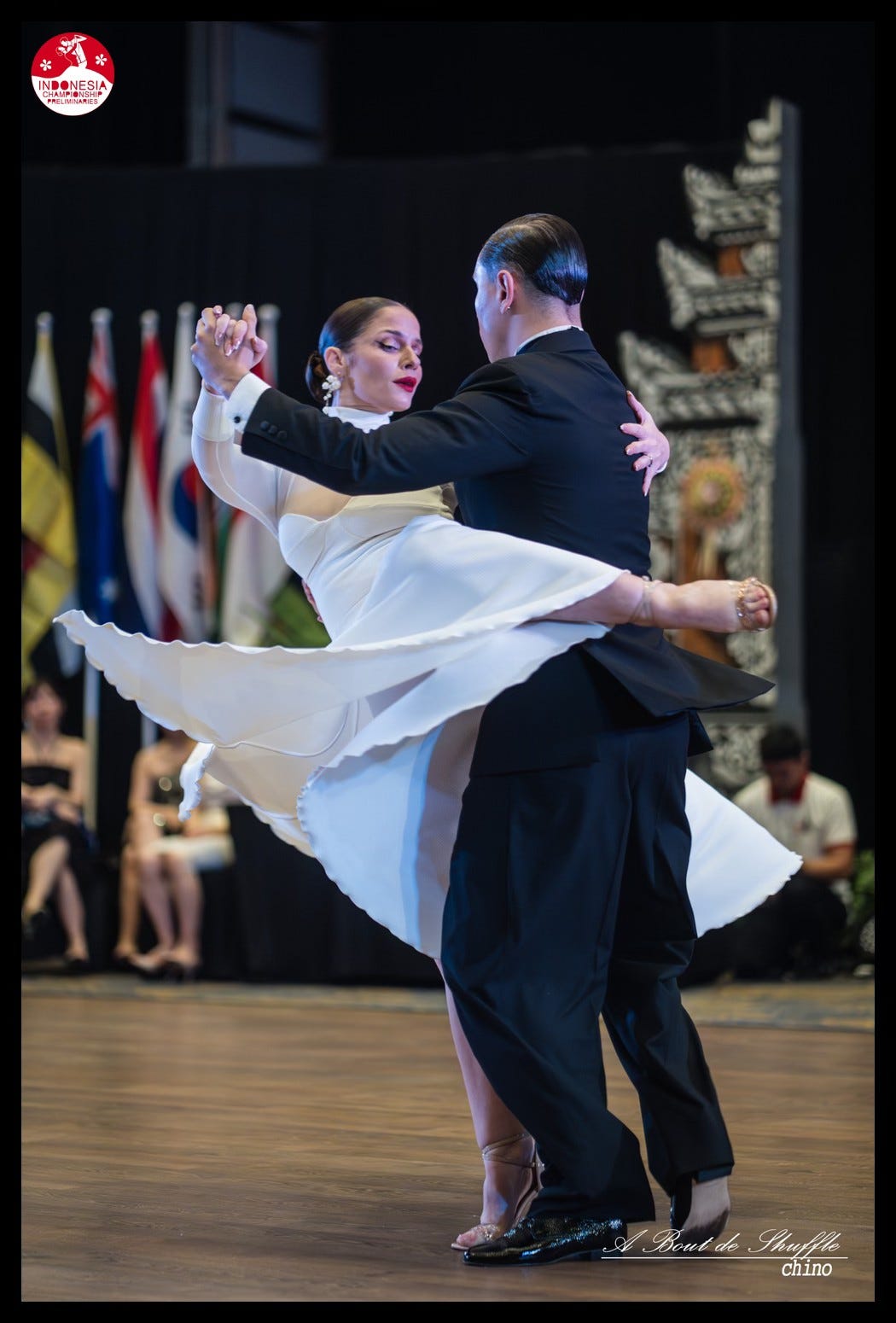Tango’s Quiroga and Carvajal
An analysis of style
Photographs herein: Quiroga and Carvajal, various credits, used with the dancers’ permission.
Journey to Luna Park
Each August in Buenos Aires, the Estadio Luna Park on Avenida Corrientes roars to life as climactic performances crown new champions and push the evolution of tango. Behind the brilliance on stage lies a lifetime of dedication—countless hours of practice, training, and immersion in the living traditions of the dance. Tango, like all cultural forms, is the product of continual evolution, shaped by a blending of influences over time. It emerged from the barrios of Buenos Aires as a fusion of African dance forms, polka, canyengue, and other folk traditions, intertwined with 19th-century European ballroom dance. Over decades, it has incorporated modern styles, evolving into a global art form while remaining rooted in Argentine identity.
Suyay Quiroga and Jonny Carvajal exemplify this ongoing evolution. Their victories at the 2023 Metropolitano (tango, vals, and milonga) and Tango de Pista rounds of the Mundial in Buenos Aires were moments of artistic significance, as does every victory in competitions at that level. Videos of their Mundial rounds, priceless references for competitors and aficionados, may be seen here and here.
Their performances, polished yet grounded, embodied the mosaic of tango’s traditions, weaving its historical influences into modern expression. Between these high-profile competitions, they exhibited their style in milongas across Buenos Aires—from Boedo to Recoleta at Yira Yira with Pugliese, Milonga Malena and Si Sos Brujo with Di Sarli, and Juernes with Laurenz and Podestá—dancing with the confidence of champions. Their style integrates all the hallmarks of elite academic tango, with an ample and effortless walk, seamless connection, smooth giros, original variations on traditional figures, and finely tuned musicality.
After their Mundial triumph, their exhibitions at En Lo de Balmaceda (tango and milonga) and in Muy Lunes (tango and milonga) featured interpretations of Rodríguez, Lomuto, Canaro, and Atilio Stampone’s 1971 rendition of Tú with Roberto Goyeneche, a gem fetched from tango’s twilight. To local milongueros and frequent tango tourists, these performances refined familiar traditions with fresh nuance and invincible energy. To global audiences, the depth of expression was one rarely seen outside Argentina.
The analysis that follows focuses on this defining moment in the artistic journey of Quiroga and Carvajal: the year 2023, when their style reached a compelling synthesis—not to enshrine them at an imagined apex but to appreciate the distinctive qualities they brought to that particular time and place.
October 2023, video by Agustina Barriagus.
Central Qualities of the Partnership
The style of Quiroga and Carvajal draws from the fabled salons of interwar Europe but transcends the upright austerity that Bernabé Simarra taught during that era, later crystallized into the sober estilo del cuarenta. This older tango de salón, most famously championed by Carlos Alberto Estévez (better known as Petróleo) and his peers, who loved uncomplicated tango, has nourished generations of choreographers and showdancers. It remains a staple of advanced rounds in the Metropolitano and Mundial.
Yet Quiroga and Carvajal do not simply adhere to this orthodox lineage. Instead, they craft a mesmerizing synthesis of modernized and vestigial forms. Their dancing evokes the picture of El Vasco Aín and a nameless female partner performing in the Vatican Library for Pope Pius XI in 1924—a moment vividly described by the Yale historian Robert Ferris Thompson in Tango: The Art History of Love. While their technical excellence secured them places in the finals of the Metropolitano and Mundial, it was their ability to innovate so skilfully upon the orthodox image of academic tango—while still projecting its rich motifs—that led them to victory. I will try to unpack this.
At the heart of their artistry is the scale of some of their most fascinating movements: small but complex. This is not minimalism but a choreography of granular precision and depth. Their tango’s mechanics reflect a telepathic connection—a fusion of physical discipline, mental acuity, and emotional resonance. Their movements, though seemingly effortless, reveal advanced coordination, akin to the organic harmony of the right hand washing the left.
This harmony, however, is not an evolutionary adaptation, but a well-rehearsed interplay of intention and response. Their vaivéns, cruzes, cortes, piques, quebradas, and rock steps are built upon a set of micro-movements that captivate connoisseurs, their complexity and refinement all but invisible to untrained eyes. Quiroga embodies an almost supernatural responsiveness, translating Carvajal’s every cue into movements of astonishing clarity, even as the signal between leader and follower approaches the edge of perceptibility.
The mastery of small movements in tango lies in their uncompromising demand for clarity, control, and coordination. As the leader’s signals diminish, the follower leans on an acute awareness of shared repertoire, an intuitive grasp of the music, and a sensitivity that borders on clairvoyance. Her ability to sustain this dialogue without interruption throughout a single song—and over the long span of a competition round—is nothing short of extraordinary. It is with this microscopic fidelity to connection and movement that Quiroga and Carvajal elevate tango to its grand ideal: a union of two persons into one entity. Difficult to concieve of in theory, this is nearly impossible in practice.
Zooming out, Quiroga and Carvajal’s style parallels the transformation of jazz during the bebop era, a revolution vividly explored in Thomas Owens’s Bebop: The Music and Its Players. Bebop redefined jazz not through sheer speed but by increasing the resolution of musical interplay—an intricate and intuitive exchange between musicians that allowed for new complexity and spontaneity. Charlie Parker and Dizzy Gillespie, like Quiroga and Carvajal, took a familiar form and distilled its vocabulary into elements so refined that their innovations seemed effortless despite being so transformative. Bebop musicians departed from the predictable rhythms of swing, crafting solos that hovered on the edge of audibility, where subtle cues made harmonies of surprising depth. Likewise, Quiroga and Carvajal’s ability to translate tango’s vocabulary into minute, improvisational movements demands clairvoyant connection.
November 2023, video by Noelia Benz.
Carvajal’s Aesthetic
Carvajal’s polished elegance evokes the archetype of the dandy tanguero, a figure whose refinement and sartorial precision conceal layers of cultural commentary and critique. His razor-sharp cortes, adept syncopations, bold quebradas, and lento walks forward (and aft) recall tango’s African roots, even as worsted wool bespoke for the pista, patent leather oxfords, and coiffure invoke images of the niño bien and, faintly, the compadrito, both mythical figures who danced for sport and style. The dandy lineage in tango also includes luminaries such as Miguel Ángel Zotto, and before him, Benito Blanquette—El Cachafaz, the ungovernable virtuoso whose dazzling footwork defeated rivals like José Méndez and El Negro Pavura in the prewar danzas de desafío, which preceded modern tango competitions.
Yet Carvajal’s confident departures from the more austere forms of salon tango—a bold chanclazo, an inventive lapiz, cascades of viboritas unspooling with ease, and playfully prolonged planeos—remind us of tango’s origins in freewheeling African dance forms and the nonchalance of pre-1914 tango. His style tempers the sharp formalism that defines the dancing of certain past Metropolitano and Mundial victors, while also softening the hyper-serious masculinity that unites the styles of Juan Carlos Copes, José Vázquez—Lampazo, Carlos Gavito, Carlos Copello, Osvaldo Zotto, Daniel Nacucchio, and others. Caravajal reimagines tango as a dance where precision and elegance are in constant dialogue with fluidity and playful spontaneity—amiability, mirth, and even humor.
The dandy archetype endures because it embodies tango’s paradoxes: refinement and rebellion, artifice and authenticity, sophistication and subversion. Born in the barrios, the dandy masked complexity with elegance, mirroring tango’s rise from Southern Cone saloons to the salons of Europe. Carvajal, a Colombian at tango’s pinnacle, exemplifies this duality. Like Carlos Gardel, the French-born voice of tango, Carvajal’s outsider status sharpens his ability to navigate and innovate within tradition. His poised presentation both honors tango’s heritage and challenges its formalism. In The Arcades Project, Walter Benjamin’s flâneur, who wandered Paris as both participant and critic, offers a parallel: immersed yet detached, questioning while engaged. In the same way, Carvajal projects the dandy’s style to probe authenticity, transforming it into a metaphor for tango itself—a dance forever balancing its raw origins with polished reinvention.
This calculated edge imbues the dandy with a latent power that transcends mere elegance. As the poet Celedonio Flores captured in his iconic Corrientes y Esmerelda, a cajetilla (old-fangled lunfardo slang for dandy) silences a crew of guapos with the sharp stroke of a boxer’s cross, vanquishing those storied street enforcers tied to Roca’s 1902 political machine. In Dandy by Agustín Irusta and Roberto Fugazot, the archetype takes on a darker, more ambivalent hue: no longer just a charming provocateur, he emerges as a feared regime informant, wielding influence over his old neighborhood while alienating his childhood friends. (The author’s original translations of these lyrics are linked). This duality—poised elegance concealing latent force—renders the dandy an enigmatic figure in tango’s narratives. His character defies simple description, embodying tensions within tango.
Quiroga’s Aesthetic
Quiroga’s dance is a study in contrasts: understated adornments paired with gestures of piercing deliberation. Her image evokes the refined niña bien of the early 20th century—a figure of bourgeois poise—while her repertoire draws on the resourcefulness of the milonguitas, celebrated for their brilliance as social dancers and competition partners in tango’s formative years. Her competition style reflects an exacting discipline: pleated black gowns that reveal only the ankles and tacos—fleeting glimpses of her full tango engineering—paired with footwork so precise it recalls a performer beneath the gilded ceilings of the Opéra Garnier.
Beneath this polished exterior lies a force of kinetic artistry, driven by advanced biomechanics. Quiroga’s mastery of her axis, torsional control, balance, and kinetic energy allows her to alternate seamlessly between stillness and explosive motion, appearing virtually motionless above the waist while channeling power from her core to her toes. Her finely tuned articulation of ankles, knees, and hips reflects tango’s African folk origins as much as the fluid innovations of modern dance—a dual heritage that endows her with remarkable versatility.
The concealment of her movements by flowing gowns heightens the mystique while gesturing to tango’s layered history. These gowns obscure details of technique, directing attention instead to her elegance and fluidity. This interplay of concealment and revelation recalls Japanese drama, as explored by Donald Keene in Nō and Bunraku: Two Forms of Japanese Theatre. In Nō, the performer’s form is shrouded, transforming minimalist gestures into symbols of spiritual resonance. In contrast, Bunraku revels in visceral realism and human emotion.
Quiroga’s performance reflects this interplay of opposites. The gowns, poised movements, and illusory passivity echo Nō’s restrained abstraction, aligning with tango’s European reinvention in the early 20th century and its evolution into the estilo del cuarenta in Argentina, when the dance was sanitized for bourgeois sensibilities. At the same time, her biomechanical sophistication—her dynamic force, torsional control, and interplay of tension and release—draws on the vitality of tango’s African roots. Like the puppeteers of Bunraku, Quiroga blends physical mastery and concealment. This fusion of African dynamism and European austerity embodies the longer sweep of tango’s history, much like the coexistence of Nō and Bunraku illustrates the richness of Japanese cultural expression.
Coda
The triumph of Quiroga and Carvajal in the 2023 Mundial carries a recursive beauty. Born in the aftermath of the 2001 peso crisis, the competition was an effort to reclaim cultural capital lost to economic upheaval and diaspora, a stage where Argentina’s finest could reaffirm their legacy. This urgency deepened in the wake of the pandemic’s long silence, which left Buenos Aires’ famed milongas and practicas in limbo. The Mundial emerged and re-emerged as proof that tango not only endures but evolves. Quiroga and Carvajal’s victory reflects this resilience, their dancing a testament to tango’s ability to bridge the global and the local. They are a contemporary pareja, showcasing the pillars and balustrades of that bridge, and perfecting a technique and repertoire through which they express their own humanity with remarkable fidelity.
© 2025 Barry Hashimoto. All rights reserved.






